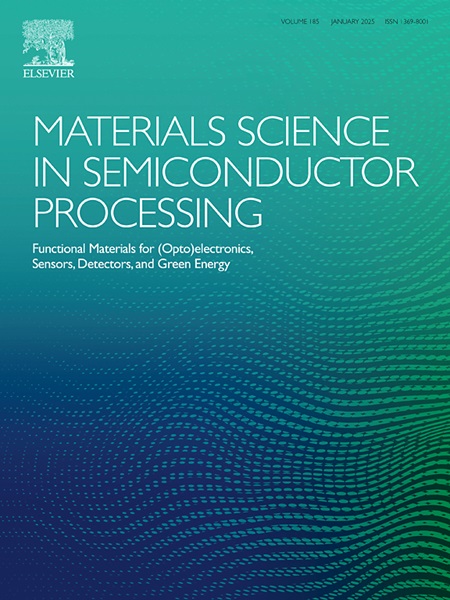The effects of CF4 plasma treatment on the performance, gate bias stability, and defect characteristics of low-temperature indium-gallium-tin-oxide thin-film transistors
IF 4.6
3区 工程技术
Q2 ENGINEERING, ELECTRICAL & ELECTRONIC
引用次数: 0
Abstract
CF4 plasma treatment, widely recognized for its use in etching processes, has emerged as an effective doping method for amorphous oxide semiconductor (AOS) based thin-film transistors (TFTs). However, a comprehensive understanding of the effects of CF4 doping on the performance, reliability, and defect characteristics of AOS-based TFTs remains limited. This study investigates the influence of CF4 plasma treatment on the electrical characteristics, bias stability, film properties, and defect profiles of amorphous In-Ga-Sn-O (a-IGTO) TFTs under varying treatment durations. As treatment time increases, the threshold voltage (Vth) shifts positively, while the subthreshold swing (SS) decreases. The field-effect mobility (μFE) initially increases but declines as treatment duration is extended. Notable improvements in Vth stability were observed under positive bias stress (PBS), negative bias stress (NBS), positive bias thermal stress (PBTS), and negative bias illumination stress (NBIS). Defect and physiochemical analyses reveal that these improvements stem from reduced deep-level oxygen vacancies and near-valence band minimum (VBM) hydrogen/oxygen-related defects. Excessive plasma exposure beyond a critical threshold, however, increases deep-level oxygen vacancies, negatively affecting performance and reliability. These findings provide valuable insights into optimizing doping strategies for developing more reliable, high-performance TFTs for advanced applications.
CF4等离子体处理对低温氧化铟镓锡薄膜晶体管性能、栅极偏置稳定性和缺陷特性的影响
CF4等离子体处理因其在蚀刻工艺中的应用而得到广泛认可,已成为基于非晶氧化物半导体(AOS)薄膜晶体管(TFTs)的有效掺杂方法。然而,对CF4掺杂对aos基tft性能、可靠性和缺陷特征的影响的全面了解仍然有限。本研究探讨了CF4等离子体处理对不同处理时间下非晶In-Ga-Sn-O (a-IGTO) tft的电学特性、偏置稳定性、薄膜性能和缺陷轮廓的影响。随着处理时间的增加,阈值电压(Vth)正移,而阈下摆幅(SS)减小。场效应迁移率(μFE)随着处理时间的延长而逐渐下降。在正偏置应力(PBS)、负偏置应力(NBS)、正偏置热应力(PBTS)和负偏置照明应力(NBIS)下,Vth稳定性显著提高。缺陷和物理化学分析表明,这些改进源于深层氧空位的减少和近价带最小(VBM)氢/氧相关缺陷。然而,超过临界阈值的过量等离子体暴露会增加深层氧空位,对性能和可靠性产生负面影响。这些发现为优化掺杂策略,开发更可靠、高性能的tft用于高级应用提供了有价值的见解。
本文章由计算机程序翻译,如有差异,请以英文原文为准。
求助全文
约1分钟内获得全文
求助全文
来源期刊

Materials Science in Semiconductor Processing
工程技术-材料科学:综合
CiteScore
8.00
自引率
4.90%
发文量
780
审稿时长
42 days
期刊介绍:
Materials Science in Semiconductor Processing provides a unique forum for the discussion of novel processing, applications and theoretical studies of functional materials and devices for (opto)electronics, sensors, detectors, biotechnology and green energy.
Each issue will aim to provide a snapshot of current insights, new achievements, breakthroughs and future trends in such diverse fields as microelectronics, energy conversion and storage, communications, biotechnology, (photo)catalysis, nano- and thin-film technology, hybrid and composite materials, chemical processing, vapor-phase deposition, device fabrication, and modelling, which are the backbone of advanced semiconductor processing and applications.
Coverage will include: advanced lithography for submicron devices; etching and related topics; ion implantation; damage evolution and related issues; plasma and thermal CVD; rapid thermal processing; advanced metallization and interconnect schemes; thin dielectric layers, oxidation; sol-gel processing; chemical bath and (electro)chemical deposition; compound semiconductor processing; new non-oxide materials and their applications; (macro)molecular and hybrid materials; molecular dynamics, ab-initio methods, Monte Carlo, etc.; new materials and processes for discrete and integrated circuits; magnetic materials and spintronics; heterostructures and quantum devices; engineering of the electrical and optical properties of semiconductors; crystal growth mechanisms; reliability, defect density, intrinsic impurities and defects.
 求助内容:
求助内容: 应助结果提醒方式:
应助结果提醒方式:


